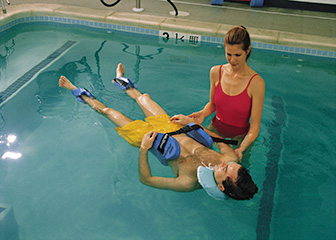
Employment of healthcare occupations is projected to grow 19 percent from 2014 to 2024, much faster than the average for all occupations, adding about 2.3 million new jobs. Healthcare occupations will add more jobs than any other group of occupations. This growth is expected due to an aging population and because federal health insurance reform should increase the number of individuals who have access to health insurance.

The median annual wage for healthcare practitioners and technical occupations (such as registered nurses, physicians and surgeons, and dental hygienists) was $62,610 in May 2015, which was higher than the median annual wage for all occupations in the economy of $36,200.
Healthcare support occupations (such as home health aides, occupational therapy assistants, and medical transcriptionists) had a median annual wage of $27,040 in May 2015, lower than the median annual wage for all occupations in the economy.
https://www.bls.gov/ooh/healthcare/home.htm
Home Health Aides

OCCUPATIONAL OUTLOOK: HOME HEALTH AIDES
|
2015 Median Pay
|
$21,920 per year
$10.54 per hourThe median annual wage for home health aides was $21,920 in May 2015. |
|
What Home Health Aides Do
|
Home health aides help people with disabilities, chronic illness, or cognitive impairment with activities of daily living. They often help older adults who need assistance. In some states, home health aides may be able to give a client medication or check the client’s vital signs under the direction of a nurse or other healthcare practitioner. |
|
Work Environment
|
Home health aides held about 913,500 jobs in 2014. They work in a variety of settings, including clients’ homes, |
|
How to Become a Home Health Aide
|
There are no formal education requirements for home health aides, but most aides have at least a high school diploma. Home health aides working in certified home health or hospice agencies must complete formal training and pass a standardized test. |
|
Job Outlook, 2014-24
|
38% (Much faster than average) |
|
Similar Occupations
|
Compare the job duties, education, job growth, and pay of home health aides with similar occupations. |
|
State & Area Data
|
Explore resources for employment and wages by state and area for home health aides. |
Bureau of Labor Statistics, U.S. Department of Labor, Occupational Outlook Handbook, 2016-17 Edition, Home Health Aides,
on the Internet at https://www.bls.gov/ooh/healthcare/home-health-aides.htm (visited February 02, 2017). |
Medical Assistants

|
OCCUPATIONAL OUTLOOK: Medical Assistants
|
|
2015 Median Pay
|
$30,590 per year
$14.71 per hourThe median annual wage for medical assistants was $30,590 in May 2015. |
|
What Medical Assistants Do
|
Medical assistants complete administrative and clinical tasks in the offices of physicians, hospitals, and other healthcare facilities. Their duties vary with the location, specialty, and size of the practice. |
|
Work Environment
|
Medical assistants held about 591,300 jobs in 2014. Most of these assistants work in physicians’ offices, hospitals, outpatient clinics, and other healthcare facilities. |
|
How to Become a Medical Assistant
|
Most medical assistants have postsecondary education such as a certificate. Others enter the occupation with a high school diploma and learn through on-the-job training. |
|
Job Outlook, 2014-24
|
23% (Much faster than average) |
|
Similar Occupations
|
Compare the job duties, education, job growth, and pay of medical assistants with similar occupations. |
|
State & Area Data
|
Explore resources for employment and wages by state and area for medical assistants. |
Bureau of Labor Statistics, U.S. Department of Labor, Occupational Outlook Handbook, 2016-17 Edition, Medical Assistants,
on the Internet at https://www.bls.gov/ooh/healthcare/medical-assistants.htm (visited February 03, 2017). |
|
|
Pharmacy Technicians

|
OCCUPATIONAL OUTLOOK: PHARMACY TECHNICIANS
|
|
2015 Median Pay
|
$30,410 per year
$14.62 per hourThe median annual wage for pharmacy technicians was $30,410 in May 2015. |
|
What Pharmacy Technicians Do
|
Pharmacy technicians help pharmacists dispense prescription medication to customers or health professionals. |
|
Work Environment
|
Pharmacy technicians work in pharmacies, including those found in grocery and drug stores, and in hospitals. Most work full time, but many work part time. |
|
How to Become a Pharmacy Technician
|
Becoming a pharmacy technician usually requires earning a high school diploma or the equivalent. Pharmacy technicians typically learn through on-the-job training, or they may complete a postsecondary education program. Most states regulate pharmacy technicians, which is a process that may require passing an exam or completing a formal education or training program. |
|
Job Outlook, 2014-24
|
9% (Faster than average) |
|
Similar Occupations
|
Compare the job duties, education, job growth, and pay of pharmacy technicians with similar occupations. |
|
State & Area Data
|
Explore resources for employment and wages by state and area for home health aides. |
Bureau of Labor Statistics, U.S. Department of Labor, Occupational Outlook Handbook, 2016-17 Edition, Home Health Aides,
on the Internet at https://www.bls.gov/ooh/healthcare/home-health-aides.htm (visited February 02, 2017). |
|
|
Dental Assistants

|
OCCUPATIONAL OUTLOOK: DENTAL ASSISTANTS
|
|
2015 Median Pay
|
$35,980 per year
$17.30 per hourThe median annual wage for dental assistants was $35,980 in May 2015. |
|
What Dental Assistants Do
|
Dental assistants perform many tasks, ranging from providing patient care and taking x rays to recordkeeping and scheduling appointments. Their duties vary by state and by the dentists’ offices where they work. |
|
Work Environment
|
Almost all dental assistants work in dentists’ offices. Most work full time. |
|
How to Become a Dental Assistant
|
There are several possible paths to becoming a dental assistant. Some states require assistants to graduate from an accredited program and pass an exam. In other states, there are no formal educational requirements. |
|
Job Outlook, 2014-24
|
18% (Much faster than average) |
|
Similar Occupations
|
Compare the job duties, education, job growth, and pay of dental assistants with similar occupations. |
|
State & Area Data
|
Explore resources for employment and wages by state and area for dental assistants.
|
| Bureau of Labor Statistics, U.S. Department of Labor, Occupational Outlook Handbook, 2016-17 Edition, Dental Assistants, on the Internet at https://www.bls.gov/ooh/healthcare/dental-assistants.htm (visited February 03, 2017). |
|
|
Nursing Assistants and Orderlies

|
OCCUPATIONAL OUTLOOK: NURSING ASSISTANTS & ORDERLIES
|
|
2015 Median Pay
|
$25,710 per year
$12.36 per hourThe median annual wage for nursing assistants and orderlies was $25,710 in May 2015. |
|
What Nursing Assistants and Orderlies Do
|
Nursing assistants, sometimes called nursing aides, help provide basic care for patients in hospitals and residents of long-term care facilities, such as nursing homes. Orderlies transport patients and clean treatment areas. |
|
Work Environment
|
Nursing assistants and orderlies work in nursing and residential care facilities and in hospitals. They are frequently physically active and may need to help lift or move patients. |
|
How to Become a Nursing Assistant or Orderly
|
Nursing assistants must complete a state-approved education program and must pass their state’s competency exam to become certified. Orderlies generally have at least a high school diploma. |
|
Job Outlook, 2014-24
|
17% (Much faster than average) |
|
Similar Occupations
|
Compare the job duties, education, job growth, and pay of nursing assistants and orderlies with similar occupations. |
|
State & Area Data
|
Explore resources for employment and wages by state and area for nursing assistants and orderlies. |
Bureau of Labor Statistics, U.S. Department of Labor, Occupational Outlook Handbook, 2016-17 Edition, Nursing Assistants and Orderlies,
on the Internet at https://www.bls.gov/ooh/healthcare/nursing-assistants.htm (visited February 03, 2017). |
|
|
Medical Records and Health Information Technicians

|
OCCUPATIONAL OUTLOOK: MEDICAL RECORDS & HEALTH INFORMATION TECHNICIANS
|
|
2015 Median Pay
|
$37,110 per year
$17.84 per hourThe median annual wage for medical records and health information technicians was $37,110 in May 2015 |
|
What Medical Records and Health Information Technicians Do
|
Medical records and health information technicians, commonly referred to as health information technicians, organize and manage health information data. They ensure that the information maintains its quality, accuracy, accessibility, and security in both paper files and electronic systems. They use various classification systems to code and categorize patient information for insurance reimbursement purposes, for databases and registries, and to maintain patients’ medical and treatment histories. |
|
Work Environment
|
Health information technicians held about 188,600 jobs in 2014. Most health information technicians work in hospitals or physicians’ offices. |
|
How to Become a Medical Records or Health Information Technician
|
Health information technicians typically need a postsecondary certificate to enter the occupation, although some may need an associate’s degree. Certification is often required. |
|
Job Outlook
|
Employment of health information technicians is projected to grow 15 percent from 2014 to 2024, much faster than the average for all occupations. The demand for health services is expected to increase as the population ages. |
|
Similar Occupations
|
Compare the job duties, education, job growth, and pay of medical records and health information technicians with similar occupations. |
|
State & Area Data
|
Explore resources for employment and wages by state and area for medical records and health information technicians. |
Bureau of Labor Statistics, U.S. Department of Labor, Occupational Outlook Handbook, 2016-17 Edition, Medical Records and Health Information Technicians,
on the Internet at https://www.bls.gov/ooh/healthcare/medical-records-and-health-information-technicians.htm (visited February 03, 2017). |
|
Medical Transcriptionists

|
OCCUPATIONAL OUTLOOK: MEDICAL TRANSCRIPTIONISTS
|
|
2015 Median Pay
|
$34,890 per year
$16.77 per hourThe median annual wage for medical transcriptionists was $34,890 in May 2015. |
|
What Medical Transcriptionists Do
|
Medical transcriptionists, sometimes referred to as healthcare documentation specialists, listen to voice recordings that physicians and other healthcare workers make and convert them into written reports. They may also review and edit medical documents created using speech recognition technology. Transcriptionists interpret medical terminology and abbreviations in preparing patients’ medical histories, discharge summaries, and other documents. |
|
Work Environment
|
Most medical transcriptionists work for hospitals, physicians’ offices, and third-party transcription service companies that provide transcription services to healthcare establishments. Others are self-employed. |
|
How to Become a Medical Transcriptionist
|
Medical transcriptionists typically need postsecondary education. Prospective medical transcriptionists must have an understanding of medical terminology, anatomy and physiology, grammar, and word-processing software |
|
Job Outlook
|
Employment of medical transcriptionists is projected to decline 3 percent from 2014 to 2024. The growing volume of healthcare services is expected to continue to increase demand for transcription services. However, employment is projected to decline because of increased productivity stemming from technological advances and outsourcing. |
|
Similar Occupations
|
Compare the job duties, education, job growth, and pay of medical transcriptionists with similar occupations. |
|
State & Area Data
|
Explore resources for employment and wages by state and area for medical transcriptionists. |
Bureau of Labor Statistics, U.S. Department of Labor, Occupational Outlook Handbook, 2016-17 Edition, Medical Transcriptionists,
on the Internet at https://www.bls.gov/ooh/healthcare/medical-transcriptionists.htm (visited February 02, 2017). |
|
|
Occupational Therapy Assistants and Aides
|

|
|
OCCUPATIONAL OUTLOOK: OCCUPATIONAL THERAPY ASSISTANTS & AIDES
|
|
2015 Median Pay
|
$54,520 per year
$26.21 per hourThe median annual wage for occupational therapy assistants and aides was $54,520 in May 2015. |
|
What Occupational Therapy Assistants and Aides Do
|
Occupational therapy assistants and aides help patients develop, recover, and improve the skills needed for daily living and working. Occupational therapy assistants are directly involved in providing therapy to patients; occupational therapy aides typically perform support activities. Both assistants and aides work under the direction of occupational therapists. |
|
Work Environment
|
Occupational therapy assistants and aides work primarily in occupational therapists’ offices, in hospitals, and in nursing care facilities. Occupational therapy assistants and aides spend much of their time on their feet, setting up equipment and, in the case of assistants, working with patients. |
|
How to Become an Occupational Therapy Assistant or Aide
|
Occupational therapy assistants need an associate’s degree from an accredited occupational therapy assistant program. In most states, occupational therapy assistants must be licensed. Occupational therapy aides typically have a high school diploma or equivalent. |
|
Job Outlook
|
Employment of occupational therapy assistants and aides is projected to grow 40 percent from 2014 to 2024, much faster than the average for all occupations. Occupational therapy will continue to be an important part of treatment for people with various illnesses and disabilities. |
|
Similar Occupations
|
Compare the job duties, education, job growth, and pay of occupational therapy assistants and aides with similar occupations. |
|
State & Area Data
|
Explore resources for employment and wages by state and area for occupational therapy assistants and aides. |
Bureau of Labor Statistics, U.S. Department of Labor, Occupational Outlook Handbook, 2016-17 Edition, Occupational Therapy Assistants and Aides,
on the Internet at https://www.bls.gov/ooh/healthcare/occupational-therapy-assistants-and-aides.htm (visited February 03, 2017). |
|
|
Physical Therapist Assistants and Aides

|
OCCUPATIONAL OUTLOOK: PHYSICAL THERAPIST ASSISTANTS & AIDES
|
|
Pay
|
$42,980 per year
$20.66 per hourThe median annual wage for physical therapist assistants and aides was $42,980 in May 2015. |
|
What Physical Therapist Assistants and Aides Do
|
Physical therapist assistants, sometimes called PTAs, and physical therapist aides work under the direction and supervision of physical therapists. They help patients who are recovering from injuries and illnesses regain movement and manage pain. |
|
Work Environment
|
Most physical therapist assistants and aides work in physical therapists’ offices or in hospitals. Physical therapist assistants and aides are frequently on their feet and moving as they set up equipment and help care for patients. |
|
How to Become a Physical Therapist Assistant or Aide
|
Physical therapist assistants entering the profession need an associate’s degree from an accredited program. All states require physical therapist assistants to be licensed or certified. Physical therapist aides usually have a high school diploma and receive on-the-job training. |
|
Job Outlook
|
Employment of physical therapist assistants and aides is projected to grow 40 percent from 2014 to 2024, much faster than the average for all occupations. Demand for physical therapy services is expected to increase in response to the healthcare needs of an older population and individuals with chronic conditions, such as diabetes and obesity. |
|
Similar Occupations
|
Compare the job duties, education, job growth, and pay of physical therapist assistants and aides with similar occupations. |
|
State & Area Data
|
Explore resources for employment and wages by state and area for physical therapist assistants and aides. |
Bureau of Labor Statistics, U.S. Department of Labor, Occupational Outlook Handbook, 2016-17 Edition, Physical Therapist Assistants and Aides,
on the Internet at https://www.bls.gov/ooh/healthcare/physical-therapist-assistants-and-aides.htm (visited February 03, 2017). |
|
|
Licensed Practical and Licensed Vocational Nurses
|
OCCUPATIONAL OUTLOOK: LICENSED PRACTICAL & LICENSED VOCATIONAL NURSES
|
|
Pay
|
$43,170 per year
$20.76 perThe median annual wage for licensed practical and licensed vocational nurses was $43,170 in May 2015. |
|
What Licensed Practical and Licensed Vocational Nurses Do
|
Licensed practical nurses (LPNs) and licensed vocational nurses (LVNs) provide basic nursing care. They work under the direction of registered nurses and doctors. |
|
Work Environment
|
Licensed practical and licensed vocational nurses work in many settings, including nursing homes and extended care facilities, hospitals, physicians’ offices, and private homes. Most work full time. |
|
How to Become a Licensed Practical or Licensed Vocational Nurse
|
Licensed practical and licensed vocational nurses must complete a state-approved educational program, which typically takes about 1 year to complete. They must also be licensed. |
|
Job Outlook
|
Employment of licensed practical and licensed vocational nurses is projected to grow 16 percent from 2014 to 2024, much faster than the average for all occupations. As the baby-boom population ages, the overall need for healthcare services is expected to increase. LPNs and LVNs will be needed in residential care facilities and in home health environments to care for older patients. |
|
Similar Occupations
|
Compare the job duties, education, job growth, and pay of licensed practical and licensed vocational nurses with similar occupations. |
|
State & Area Data
|
Explore resources for employment and wages by state and area for licensed practical and licensed vocational nurses. |
Bureau of Labor Statistics, U.S. Department of Labor, Occupational Outlook Handbook, 2016-17 Edition, Licensed Practical and Licensed Vocational Nurses,
on the Internet at https://www.bls.gov/ooh/healthcare/licensed-practical-and-licensed-vocational-nurses.htm(visited February 03, 2017).). |
|
|
Registered Nurses

|
OCCUPATIONAL OUTLOOK: REGISTERED NURSES
|
|
|
Pay
|
The median annual wage for registered nurses was $67,490 in May 2015. |
|
What Registered Nurses Do
|
Registered nurses (RNs) provide and coordinate patient care, educate patients and the public about various health conditions, and provide advice and emotional support to patients and their family members. |
|
Work Environment
|
Registered nurses work in hospitals, physicians’ offices, home healthcare services, and nursing care facilities. Others work in correctional facilities or schools, or serve in the military. |
|
How to Become a Registered Nurse
|
Registered nurses usually take one of three education paths: a bachelor’s degree in nursing, an associate’s degree in nursing, or a diploma from an approved nursing program. Registered nurses also must be licensed. |
|
Job Outlook
|
Employment of registered nurses is projected to grow 16 percent from 2014 to 2024, much faster than the average for all occupations. Growth will occur for a number of reasons, including an increased emphasis on preventive care; growing rates of chronic conditions, such as diabetes and obesity; and demand for healthcare services from the baby-boom population, as they live longer and more active lives. |
|
Similar Occupations
|
Compare the job duties, education, job growth, and pay of registered nurses with similar occupations. |
|
State & Area Data
|
Explore resources for employment and wages by state and area for registered nurses. |
Bureau of Labor Statistics, U.S. Department of Labor, Occupational Outlook Handbook, 2016-17 Edition, Registered Nurses,
on the Internet at https://www.bls.gov/ooh/healthcare/registered-nurses.htm (visited February 02, 2017). |
|
|
RADIOLOGIC & MRI TECHNOLOGISTS

|
OCCUPATIONAL OUTLOOK: RADIOLOGIC & MRI TECHNOLOGISTS
|
|
|
Pay
|
$58,120 per year
$27.94 per hourThe median annual wage for radiologic and MRI technologists was $58,120 in May 2015. |
|
What Radiologic and MRI Technologists Do
|
Radiologic technologists, also known as radiographers, perform diagnostic imaging examinations, such as x rays, on patients. MRI technologists operate magnetic resonance imaging (MRI) scanners to create diagnostic images. |
|
Work Environment
|
Radiologic and MRI technologists work in healthcare facilities, and more than half work in hospitals. |
|
How to Become a Radiologic or MRI Technologist
|
Radiologic technologists and MRI technologists typically need an associate’s degree. Many MRI technologists start out as radiologic technologists and specialize later in their career. Radiologic technologists must be licensed or certified in most states. Few states license MRI technologists. Employers typically require or prefer prospective technologists to be certified even if the state does not require it. |
|
Job Outlook
|
Employment of radiologic and MRI technologists is projected to grow 9 percent from 2014 to 2024, faster than the average for all occupations. As the population grows older, there will be an increase in medical conditions that require imaging as a tool for making diagnoses |
|
Similar Occupations
|
Compare the job duties, education, job growth, and pay of radiologic and MRI technologists with similar occupations. |
|
State & Area Data
|
Explore resources for employment and wages by state and area for radiologic and MRI technologists. |
Bureau of Labor Statistics, U.S. Department of Labor, Occupational Outlook Handbook, 2016-17 Edition, Radiologic and MRI Technologists,
on the Internet at https://www.bls.gov/ooh/healthcare/radiologic-technologists.htm (visited February 03, 2017). |
|
|
Nurse Anesthetists, Nurse Midwives, and Nurse Practitioners

|
OCCUPATIONAL OUTLOOK: NURSE ANESTHETISTS, NURSE MIDWIVES & NURSE PRACTICIONERS
|
|
|
Pay
|
$104,740 per year
$50.36 per hourThe median annual wage for nurse anesthetists, nurse midwives, and nurse practitioners was $104,740 in May 2015. |
|
What Nurse Anesthetists, Nurse Midwives, and Nurse Practitioners Do
|
Nurse anesthetists, nurse midwives, and nurse practitioners, also referred to as advanced practice registered nurses (APRNs), coordinate patient care and may provide primary and specialty healthcare. The scope of practice varies from state to state. |
|
Work Environment
|
Nurse anesthetists, nurse midwives, and nurse practitioners work in a wide variety of healthcare settings, including hospitals, physicians’ offices, schools, and clinics. Most APRNs work full time. |
|
How to Become a Nurse Anesthetist, Nurse Midwife, or Nurse Practitioner
|
Nurse anesthetists, nurse midwives, and nurse practitioners must earn at least a master’s degree in one of the APRN roles. They must also be licensed in their state and pass a national certification exam. |
|
Job Outlook
|
Employment of nurse anesthetists, nurse midwives, and nurse practitioners is projected to grow 31 percent from 2014 to 2024, much faster than the average for all occupations. Growth will occur primarily because of the effects of healthcare legislation, an increased emphasis on preventive care, and demand for healthcare services from the large, aging baby-boom population as they live longer and more active lives than previous generations. |
|
Similar Occupations
|
Compare the job duties, education, job growth, and pay of nurse anesthetists, nurse midwives, and nurse practitioners with similar occupations. |
|
State & Area Data
|
Explore resources for employment and wages by state and area for nurse anesthetists, nurse midwives, and nurse practitioners. |
Bureau of Labor Statistics, U.S. Department of Labor, Occupational Outlook Handbook, 2016-17 Edition, Nurse Anesthetists, Nurse Midwives, and Nurse Practitioners,
on the Internet at https://www.bls.gov/ooh/healthcare/nurse-anesthetists-nurse-midwives-and-nurse-practitioners.htm (visited February 03, 2017). |
|
|
Social Workers

|
OCCUPATIONAL OUTLOOK: SOCIAL WORKER
|
|
|
Pay
|
$45,900 per year
$22.07 per hourThe median annual wage for social workers was $45,900 in May 2015. |
|
What Social Workers Do
|
Social workers help people solve and cope with problems in their everyday lives. One group of social workers—clinical social workers—also diagnose and treat mental, behavioral, and emotional issues. |
|
Work Environment
|
Social workers are employed in a variety of settings, including mental health clinics, schools, child welfare and human service agencies, hospitals, settlement houses, community development corporations, and private practices. They generally work full time and may need to work evenings, weekends, and holidays. |
|
How to Become a Social Worker
|
Although most social workers need a bachelor’s degree in social work, clinical social workers must have a master’s degree and 2 years of post-master’s experience in a supervised clinical setting. Clinical social workers must also be licensed in the state in which they practice |
|
Job Outlook
|
Employment of social workers is projected to grow 12 percent from 2014 to 2024, faster than the average for all occupations. Employment growth will be driven by increased demand for healthcare and social services, but will vary by specialty. |
|
Similar Occupations
|
Compare the job duties, education, job growth, and pay of social workers with similar occupations. |
|
State & Area Data
|
Explore resources for employment and wages by state and area for social workers. |
Bureau of Labor Statistics, U.S. Department of Labor, Occupational Outlook Handbook, 2016-17 Edition, Social Workers,
on the Internet at https://www.bls.gov/ooh/community-and-social-service/social-workers.htm (visited February 03, 2017). |
|
|
Health Educators and Community Health Workers

|
OCCUPATIONAL OUTLOOK: HEALTH EDUCATOR
|
|
|
Pay
|
$43,840 per year
$21.08 per hourThe median annual wage for health educators and community health workers was $43,840 in May 2015. |
|
What Health Educators and Community Health Workers Do
|
Health educators teach people about behaviors that promote wellness. They develop and implement strategies to improve the health of individuals and communities. Community health workers collect data and discuss health concerns with members of specific populations or communities. |
|
Work Environment
|
Health educators and community health workers work in a variety of settings, including hospitals, nonprofit organizations, government, doctors’ offices, private businesses, and colleges. They generally work full time. |
|
How to Become a Health Educator or Community Health Worker
|
Health educators need a bachelor’s degree. Many employers require the Certified Health Education Specialist (CHES) credential. Requirements for community health workers vary, although they typically have at least a high school diploma and must complete a brief period of on-the-job training. Some states have certification programs for community health workers. |
|
Job Outlook
|
Employment of health educators and community health workers is projected to grow 13 percent from 2014 to 2024, faster than the average for all occupations. Growth will be driven by efforts to improve health outcomes and to reduce healthcare costs by teaching people healthy habits and behaviors and explaining how to use available healthcare services. |
|
Similar Occupations
|
Compare the job duties, education, job growth, and pay of health educators and community health workers with similar occupations. |
|
State & Area Data
|
Explore resources for employment and wages by state and area for health educators and community health workers. |
Bureau of Labor Statistics, U.S. Department of Labor, Occupational Outlook Handbook, 2016-17 Edition, Health Educators and Community Health Workers,
on the Internet at https://www.bls.gov/ooh/community-and-social-service/health-educators.htm (visited February 03, 2017). |
|
|
Dietitians and Nutritionists

|
OCCUPATIONAL OUTLOOK: DIETITIAN OR NUTRITIONIST
|
|
|
Pay
|
$57,910 per year
$27.84 per hourThe median annual wage for dietitians and nutritionists was $57,910 in May 2015. |
|
What Dietitians and Nutritionists Do
|
Dietitians and nutritionists are experts in the use of food and nutrition to promote health and manage disease. They advise people on what to eat in order to lead a healthy lifestyle or achieve a specific health-related goal. |
|
Work Environment
|
Dietitians and nutritionists work in many settings, including hospitals, nursing homes, clinics, and cafeterias; or for state and local governments. |
|
How to Become a Dietitian or Nutritionist
|
Most dietitians and nutritionists have a bachelor’s degree and have completed supervised training through an internship. Many states require dietitians and nutritionists to be licensed. |
|
Job Outlook Job OutlookJob Outlook
|
Employment of dietitians and nutritionists is projected to grow 16 percent from 2014 to 2024, much faster than the average for all occupations. The role of food in preventing and treating illnesses, such as diabetes, is now well known. More dietitians and nutritionists will be needed to provide care for patients with various medical conditions and to advise people who want to improve their overall health. |
|
Similar Occupations
|
Compare the job duties, education, job growth, and pay of dietitians and nutritionists with similar occupations. |
|
State & Area Data
|
Explore resources for employment and wages by state and area for dietitians and nutritionists. |
Bureau of Labor Statistics, U.S. Department of Labor, Occupational Outlook Handbook, 2016-17 Edition, Dietitians and Nutritionists,
on the Internet at https://www.bls.gov/ooh/healthcare/dietitians-and-nutritionists.htm (visited February 03, 2017). |
|
|
Physicians and Surgeons
|
OCCUPATIONAL OUTLOOK: PHYSICIANS
|
|
|
Pay
|
This wage is equal to or greater than $187,200 per year or $90.00 per hour.
Wages for physicians and surgeons are among the highest of all occupations. The Pay tab has compensation data from the Medical Group Management Association’s Physician Compensation and Production Survey. |
|
What Physicians and Surgeons Do
|
Physicians and surgeons diagnose and treat injuries or illnesses. Physicians examine patients; take medical histories; prescribe medications; and order, perform, and interpret diagnostic tests. They counsel patients on diet, hygiene, and preventive healthcare. Surgeons operate on patients to treat injuries, such as broken bones; diseases, such as cancerous tumors; and deformities, such as cleft palates. |
|
Work Environment
|
Physicians and surgeons held about 708,300 jobs in 2014. Many physicians work in private offices or clinics, often with administrative and healthcare personnel. |
|
How to Become a Physician or Surgeon
|
Physicians and surgeons have demanding education and training requirements. Almost all physicians complete at least 4 years of undergraduate school, 4 years of medical school, and, depending on their specialty, 3 to 7 years in internship and residency programs. |
|
Job Outlook
|
Employment of physicians and surgeons is projected to grow 14 percent from 2014 to 2024, much faster than the average for all occupations. Job growth is projected due to increased demand for healthcare services by the growing and aging population. |
|
Similar Occupations
|
Compare the job duties, education, job growth, and pay of physicians and surgeons with similar occupations. |
|
State & Area Data
|
Explore resources for employment and wages by state and area for physicians and surgeons. |
Bureau of Labor Statistics, U.S. Department of Labor, Occupational Outlook Handbook, 2016-17 Edition, Physicians and Surgeons,
on the Internet at https://www.bls.gov/ooh/healthcare/physicians-and-surgeons.htm (visited February 02, 2017). |
|
|


Candela Citations
CC licensed content, Shared previously















